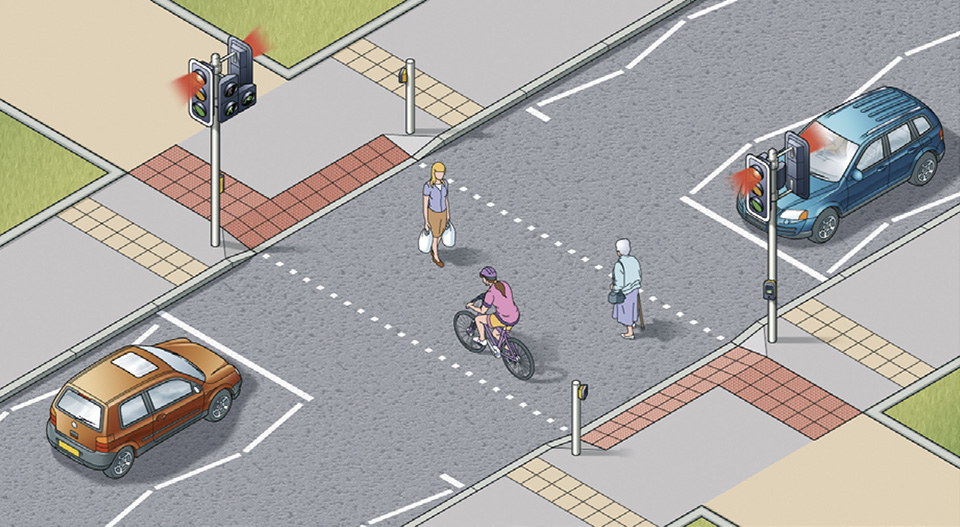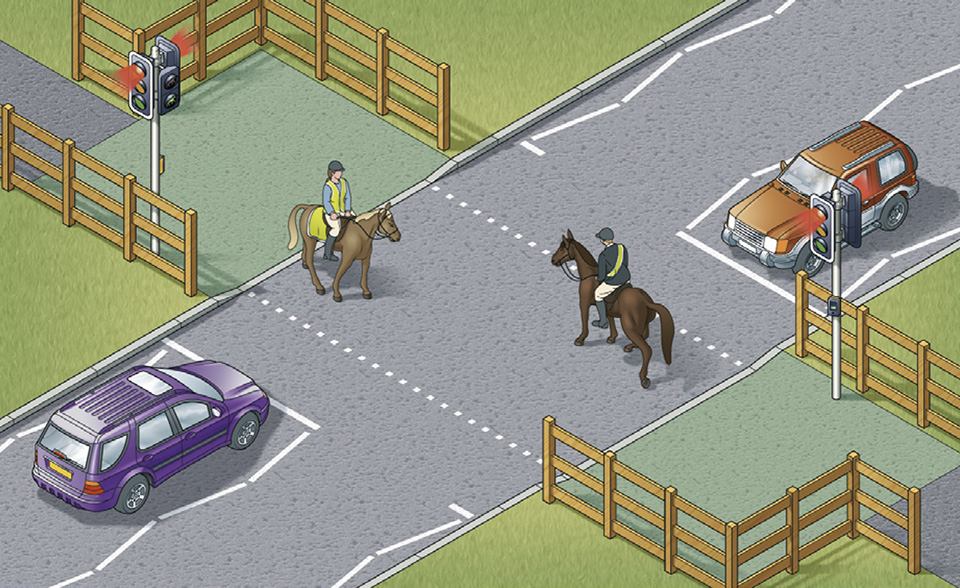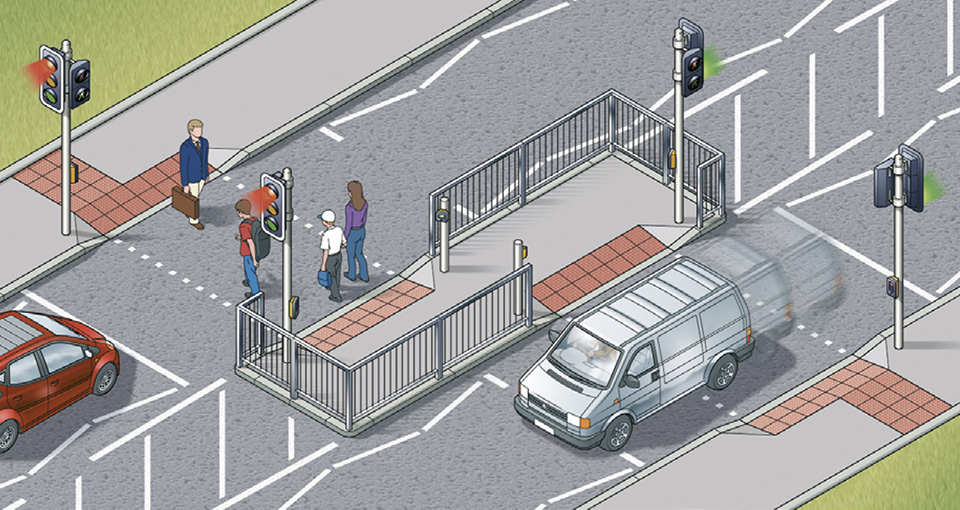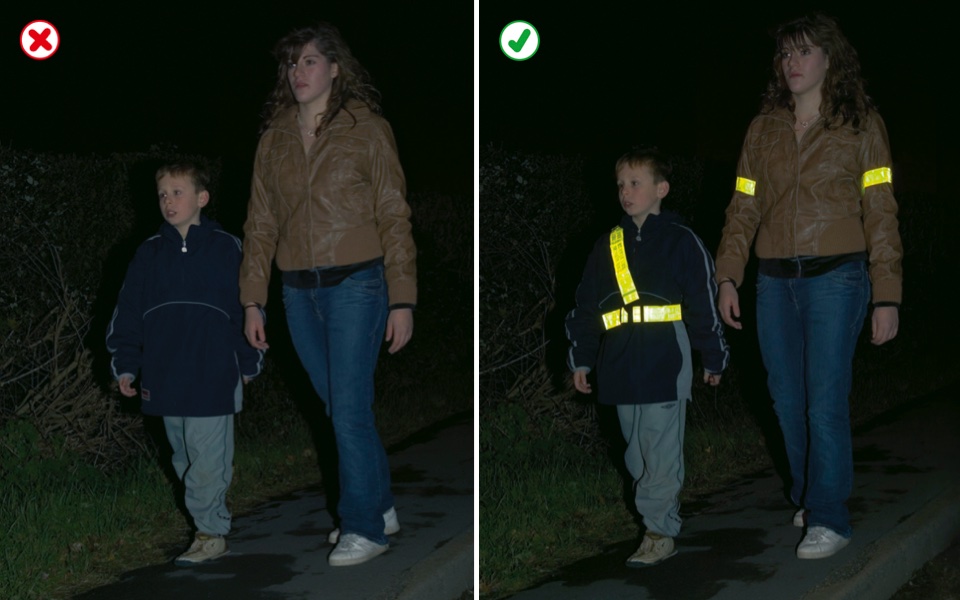Highway Code Rule 23
Puffin crossings differ from pelican crossings as the red and green figures are above the control box on your side of the road and there is no flashing green figure phase. Press the button and wait for the green figure to show.
Section: Rules for pedestrians (rules 1 to 35) Subsection: Crossings (rules 18 to 30)Highway Code Rule 24
When the road is congested, traffic on your side of the road may be forced to stop even though their lights are green. Traffic may still be moving on the other side of the road, so press the button and wait for the signal to cross.
Section: Rules for pedestrians (rules 1 to 35) Subsection: Crossings (rules 18 to 30)Highway Code Rule 25
Toucan crossings are light-controlled crossings which allow cyclists and pedestrians to share crossing space and cross at the same time. They are push-button operated. Pedestrians and cyclists will see the green signal together. Cyclists are permitted to ride across.

Highway Code Rule 26
At some crossings there is a bleeping sound or voice signal to indicate to blind or partially sighted people when the steady green figure is showing, and there may be a tactile signal to help deafblind people.
Section: Rules for pedestrians (rules 1 to 35) Subsection: Crossings (rules 18 to 30)Highway Code Rule 27
Equestrian crossings are for horse riders. They have pavement barriers, wider crossing spaces, horse and rider figures in the light panels and either two sets of controls (one higher), or just one higher control panel.

Highway Code Rule 28
Staggered’ pelican or puffin crossings. When the crossings on each side of the central refuge are not in line they are two separate crossings. On reaching the central island, press the button again and wait for a steady green figure.

Highway Code Rule 29
Crossings controlled by an authorised person. Do not cross the road unless you are signalled to do so by a police officer, traffic warden or school crossing patrol. Always cross in front of them.
Section: Rules for pedestrians (rules 1 to 35) Subsection: Crossings (rules 18 to 30)Highway Code Rule 3
Help other road users to see you. Wear or carry something light-coloured, bright or fluorescent in poor daylight conditions. When it is dark, use reflective materials (eg armbands, sashes, waistcoats, jackets, footwear), which can be seen by drivers using headlights up to three times as far away as non-reflective materials.

Highway Code Rule 30
Where there are no controlled crossing points available it is advisable to cross where there is an island in the middle of the road. Use the Green Cross Code (see Rule 7) to cross to the island and then stop and use it again to cross the second half of the road.
Section: Rules for pedestrians (rules 1 to 35) Subsection: Crossings (rules 18 to 30)Highway Code Rule 31
Emergency vehicles. If an ambulance, fire engine, police or other emergency vehicle approaches using flashing blue lights, headlights and/or sirens, keep off the road.
Section: Rules for pedestrians (rules 1 to 35) Subsection: Situations needing extra care (rules 31 to 35)Highway Code Rule 32
Buses. Get on or off a bus only when it has stopped to allow you to do so. Watch out for cyclists when you are getting off. Never cross the road directly behind or in front of a bus. Wait until it has moved off and you can see clearly in both directions.
Section: Rules for pedestrians (rules 1 to 35) Subsection: Situations needing extra care (rules 31 to 35)Highway Code Rule 33
Tramways. These may run through pedestrian areas. Their path will be marked out by shallow kerbs, changes in the paving or other road surface, white lines or yellow dots. Cross at designated crossings where provided. Elsewhere treat trams as you would other road vehicles and look both ways along the track before crossing. Do not walk along the track as trams may come up behind you. Trams move quietly and cannot steer to avoid you.
Section: Rules for pedestrians (rules 1 to 35) Subsection: Situations needing extra care (rules 31 to 35)Highway Code Rule 34
Railway level crossings. You MUST NOT cross or pass a stop line when the red lights show, (including a red pedestrian figure). Also do not cross if an alarm is sounding or the barriers are being lowered. The tone of the alarm may change if another train is approaching. If there are no lights, alarms or barriers, stop, look both ways and listen before crossing. A tactile surface comprising rounded bars running across the direction of pedestrian travel may be installed on the footpath approaching a level crossing to warn visually impaired people of its presence. The tactile surface should extend across the full width of the footway and should be located at an appropriate distance from the barrier or projected line of the barrier.
Law
Section: Rules for pedestrians (rules 1 to 35) Subsection: Situations needing extra care (rules 31 to 35)Highway Code Rule 35
Street and pavement repairs. A pavement may be closed temporarily because it is not safe to use. Take extra care if you are directed to walk in or to cross the road.
Section: Rules for pedestrians (rules 1 to 35) Subsection: Situations needing extra care (rules 31 to 35)Highway Code Rule 4
Young children should not be out alone on the pavement or road (see Rule 7). When taking children out, keep between them and the traffic and hold their hands firmly. Strap very young children into push-chairs or use reins. When pushing a young child in a buggy, do not push the buggy into the road when checking to see if it is clear to cross, particularly from between parked vehicles.
Section: Rules for pedestrians (rules 1 to 35) Subsection: General guidance (rules 1 to 6)
